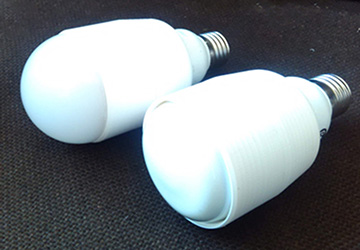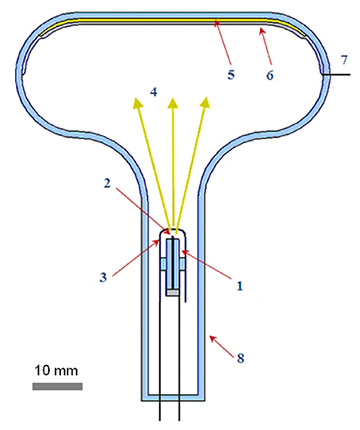
Prototype cathodoluminescent bulbs, with (left) and without (right) a diffuser, developed by engineers at MIPT and the Lebedev Physical Institute. [Image: courtesy of the researchers]
Power-saving light-emitting diode (LED) lamps are fast reshaping illumination’s cost and energy landscape, with long service lifetimes and high output in lumens per watt (lm/W). But LEDs don’t have everything. For example, operating these devices in high-temperature environments can shorten their useful lives by up to a factor of three. And many inorganic-LED bulbs include a variety of so-called critical raw materials, such as gallium, indium and rare-earth elements, that could face supply bottlenecks in the future.
Engineering researchers in Russia have now demonstrated a different lighting architecture that they believe gets around some of these problems—an architecture that rests on the same vintage technology that drove old cathode-ray-tube TV screens (J. Vac. Sci. Technol. B, doi: 10.1116/1.5070108). The team reports that its cathodoluminescent lamp (CLL) prototypes, which comprise only “very abundant materials,” can achieve luminous fluxes of some 250 lm, equivalent to that of a 25-W incandescent lamp, with a wall-plug power draw of only 5.5 W.
While the researchers don’t expect their designs to supplant LEDs, they believe that the CLLs could form a nice complement to LED lamps in the overall lighting picture, especially in applications at extreme temperatures. And they also note that, as they do not contain mercury and can emit at a broad range of wavelengths, including ultraviolet, the CLLs could prove well positioned to replace compact UV fluorescent lamps, which are under threat from international bans on mercury-containing devices.
A TV tube in a light bulb?
Superficially, the design by the Russian group—which includes researchers from the Moscow Institute of Physics and Technology (MIPT) and the Lebedev Physical Institute of the Russian Academy of Sciences—resembles an old CRT, with a cathode at one end serving as an electron gun, and a positively charged, phosphor-coated anode at the other end. The electrons, accelerated by a potential difference of up to 10 kV, plow into the phosphor and cause it to glow, creating light.

Schematic of the CLL design from the Russian team. 1 – cathode–modulator unit; 2 – cathode; 3 – modulator; 4 – emitted electrons; 5 – luminophore; 6 – aluminum mirror; 7 – anode output; 8 – glass vacuum envelope. [Image: courtesy of the researchers]
The MIPT–Lebedev team is far from the first group to look at adapting TV tube technology to illumination; indeed, it’s been an area of study since the 1980s. The key to turning such a design into a workable light bulb, however, lies in the details.
For starters, as the foundation for the cathode, the group used a bundle of carbon fibers, which are known to remain stable in vacuum conditions for long operation times, with service lifetimes potentially exceeding 10,000 hours. Moreover, the design generates electrons through field emission (emission in a strong electrostatic field, driven by the quantum-mechanical process of tunneling) rather than by thermal emission. That “cold cathode” design both improves energy efficiency and eliminates the warm-up times that had doomed previous attempts at workable CLLs.
On the anode side, the team employed the standard manufacturing technology used for monochrome TV screens to deposit the phosphors in a 10-to-30-micron-thick layer. Then, the researchers applied a smooth reflective surface of aluminum to the phosphor layer, to eke out the maximum brightness and luminous efficiency, and to ensure a reliable charge drain. They put the anode and cathode together in a glass vacuum envelope and evacuated the envelope to a pressure of 10–6 Torr.
Efficiency and illumination tests
In tests of prototypes—which included an embedded voltage converter and had a rated wall-plug power of 5.5 W, and which explored a variety of luminophore compositions—the bulbs churned out luminous fluxes ranging from 200 to 400 lm, equivalent to those of 20-to-40-W incandescent lamps. Luminous efficiencies reached 30 to 40 lm/W; that’s at the low end of the range for LEDs, and comparable to the levels of compact fluorescent bulbs. The team believes that those values could eventually be pushed up to as high as 110 lm/W via the development of better luminophores.
The researchers suggest that their device, which relies on commonplace materials and standard manufacturing techniques, should be easily adaptable to mass production. They also point out that the design makes very little use of potentially supply-constrained critical materials such as gallium, indium and rare-earth elements, and that the bulbs can stand up to use at ambient temperatures as high as 100 °C. “Unlike the LED bulb, our lamp is not afraid of elevated temperatures,” Dmitry Ozol from MIPT, a coauthor on the study, said in a press release. “You can use it where diodes quickly fade, such as in ceiling spotlights, where insufficient cooling is provided.”
In the same release, the MIPT–Lebedev group highlighted another potential advantage of the design: because the CLLs can emit across a range of wavelengths depending on the luminophore, the scheme could be used to construct ultraviolet lamps. Such lamps—widely used in water treatment, medical settings, greenhouses and elsewhere—currently rest on fluorescent-tube technologies, which are now under threat from the United Nations Minamata Convention, a 2017 treaty that calls for the international phase-out of mercury-containing appliances. CLL technology, the team believes, could prove a useful successor technology to UV fluorescents in some of these markets.
